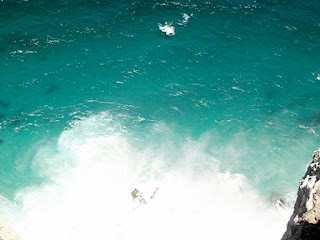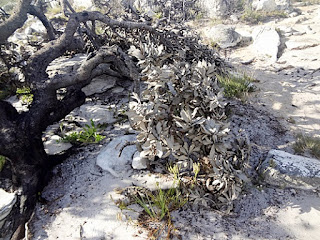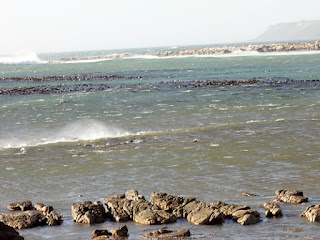Karen at the Cape Point on a very windy day. Cape Point is the Southwestern most point of the continent of Africa.
Cape Point vineyards. Beautiful grounds and the home of a favorite wine, Splattered Toad. There are South African Leopard Toads in the area and signs caution drivers about them. Apparently, some get squished from time to time, hence the name of the new cult wine.
The road heading out to the cape along the coast.The winds blow up the edges of the mountains and form clouds that blow across the tops of the mountains here. Very interesting to watch them.
An old tree at the visitor's center on the road to the cape
Some of the info about the life on the cape and in the area on a display at the visitor center.
A baleen from a baleen whale. These are used to strain small animals out of the water as the whale feeds.
People from all countries and cultures make the trek to the Cape Point Lighthouse.
This little stone battlement on the cliff at the point says it was a secret WW2 Radar Station in 1943.
Looking down over the battlement wall into the spray from crashing waves. Don't do this if you have vertigo!
The colors are beautiful, but I wouldn't want to be in that water. It's cold and pounding into the rocks on the shore. Shipwrecked people were better off not trying to land their lifeboats here; rather they should have waited for rescue boats from the other side of the cape to come around to collect them.
Looking down a gorge near the point.That is the Cape Point out there at the end. You could walk out to the very tip of the land, but it was a very windy day and a long walk, so I let Jason go with Jim while Linda and I hung around the lighthouse.
The Cape Point lighthouse.
Another look at the ocean below. This is the Southern Atlantic Ocean here now.
A zonnard, a kind of horned lizard.
A closeup of the zonnard as he started to jove away.
The lighthouse is an old one. They built it up higher, but the fog came in and blocked the light so ships couldn't see it. So they lowered the lighthouse to shine below the fog level.
Jason and Jim contemplating the history of the Cape.
Looking back w Simon's Town from the Cape Point. You can see the cloud forming at the top of the point in the distance.
A signpost at the base of the lighthouse confirms we are a long ways from home/
Linda hanging on in the wind as we walk the stone steps from the lighthouse.
Jim and Jason take off on the walk to the very end of the Cape.
The succulents that grow out here are pretty when in bloom. This is some kind of Erica, I believe. I liked the red fringe on the leaves.
Back down at sea level, we drove around the coast to see the beach level. Waves meet and peak and the tops blow off on a rocky shore littered with kelp.
The Cape ofGood Hope. We'd have to round this cape to get from Simon's Town to Cape Town to clear out of the country. We wouldn't/couldn't do it on a windy day.
A sea sponge that has been blown ashore.
The rocky shore with waves that come from the southwest all the time. Nothing between here and the South Pole to slow them down. The weather systems march across the Southern Atlantic unimpeded, so we just have to wait for a break.
I found a chunk of charcoal and marked my passing here. It will wash away with the next storm. Some shipwrecks have left ancient coal from their engine rooms, but I think this was more likely from a fire on the cape. We've seen fires almost daily out here. The arsonists are busy destroying the landscape here.
I found these two bird's eggs in a sort of nest along the shore. It was tucked in behind a bit of seaweed, with just some shells for the nesting. A black bird squawked at us as we neared it, so I'm sure it was the mother.
I also found this big shell wedged between some rocks. The outer coating has been mostly chipped or worn away, leaving a shiny nacre finish. It went into my new Zulu basket.
The ropy looking stalks of kelp washed onto the rocks.
A bright yellow growth of fungus or lichen on these rocks gave the shore here a bit of color.
Linda trying to capture a plastic bag without getting wet. Her only available tool was a limp kelp stalk and it wasn't strong enough to catch the plastic. It got loose, though, so we hope it floated ashore somewhere where someone will pick it up and dispose of it properly.
Linda searching for shells along the beach. Lots of limpets and some small shells, but not much makes it through that surf on the rocks to the beach.
The rugged coast of SW Africa. Whitecaps as far as the eye can see. I'm glad we aren't out there.
Distant peaks looking back along the coastline.
The cross of Bartholomew Dias, one of the first European explorers to claim this land. Fernando De Gama also has a matching cross on the other side of the peninsula.
This long-tailed bird was sitting on a bush but the wind kept whipping its tail out behind him.
A sandy shore where the waves roll in........
The wind and waves rush up this narrow valley of sand, leaving streaks in their wake. You can see some boulders just peeking up through the sand on the left.
Looking farther to the right, it almost looks like a glacier. The wind blows the sand all the way through this little valley and out onto the other side.
The beach to the left of the valley shows the rollers coming in nonstop.
A close-up of those boulders sticking up in the sand valley. They don't really look real.

Some cormorants out on the rocks. With the wind keeping everything in motion, the shot is a bit blurred and reminds me of an old masters painting.
Not much grows on this cape. Fynbos (meaning fine bush) are a collection of native bushes and succulents that grow here.
A white pickup truck in the center of this shot gives some scale for reference.
Locals come to a beach on the Cape with tents to keep them out of the wind, blowing sand and sun.
Seagulls line up along the edge of a natural infinity pool built at the beach for swimmers.
The leopard tortoise lives out here and drivers are cautioned to watch out for them.
Another fynbos plant, a type of Erica.
Cool rock formations on the west coast.
These tiny seed pods landed in the lee of this rock and will hopefully germinate and grow. Fires have devastated this land recently. You can see the ash along the edges.
Linda getting closeups of some rock formations.
This one in the distance looked like a dragon's head to me.
This local shrub is everywhere, but here it is grey with scorched wood and leaves.
You can see piles of black ash in the sand. The white sands here have been mixed with so much ash that they are now grey.
One of the tortoises that live out here. I picked him up to get a photo and he pissed at me.
These sable antelope were munching along the roadside on a less-traveled road along the cape shore.
The wind is blowing the tops off the waves, even where it is only a few feet deep here.
The big fields of kelp help keep the big rollers down near the shore.
A shallow rocky inlet that promised more good shelling, but it was getting late and the men were waiting for us in the car. There is a herd of the sable antelope in the distance here.
A lovely purple heather growing in clumps in the fields along the road.
The tufts of white flowers looked so soft among he fields of grasses.
Always gotta watch out for those pesky baboons! I watched one come up to a young man and aggressively snatch a plastic bag out of his hands while baring his teeth and snarling at him. He ran away down the hill, leaving the young man surprised but still safe. Feeding them is a death sentence for them as they then get aggressive and want food and can be dangerous when they will attack to get it. Rustling plastic bags is a no-no around them.

































































No comments:
Post a Comment